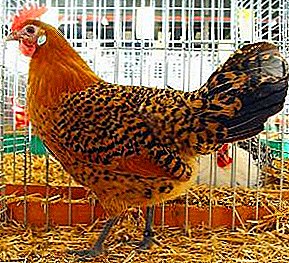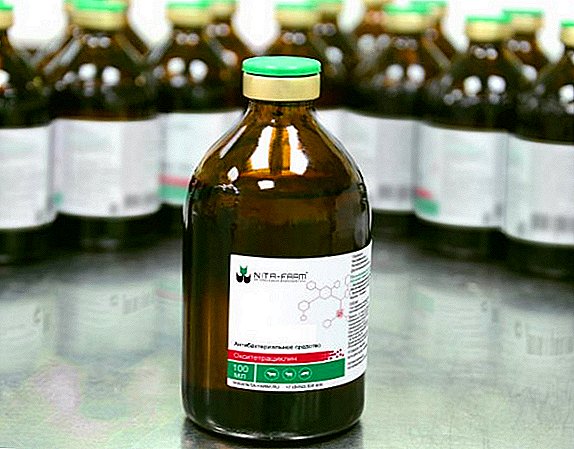 Tylosin - It is a highly effective antibiotic from the group of macrolides that make up the component that is active on gram-positive and gram-negative bacteria.
Tylosin - It is a highly effective antibiotic from the group of macrolides that make up the component that is active on gram-positive and gram-negative bacteria.
Description and composition of Tylosin 50
Tylosin is produced in hermetically sealed glass vials, which are sealed with rolled up aluminum caps and rubber stoppers. The drug was developed specifically for use in veterinary medicine. The drug inhibits bacterial protein synthesis by binding the constituent to the active substance using ribose. According to the degree of impact on the animal organism, the drug is of little danger. Its leaving component is excreted from the body with bile secretion and urine, in females - with milk and during lactation.
Did you know? The drug Tylosin 50 has low toxicity, due to which it is widely known.
Biological properties of the drug, as Tylosin 50
The following pharmacological properties of the drug can be distinguished:
 antibacterial action. The drug is referred to as macrolide antibiotics with a pronounced antibacterial effect, which applies to animals of different species;
antibacterial action. The drug is referred to as macrolide antibiotics with a pronounced antibacterial effect, which applies to animals of different species;- the effect on gram-negative and gram-positive bacteria, including staphylococcus and streptococcus, which cause pneumonia in animals;
- inhibition of protein synthesis in pathological microorganisms;
- thanks to intramuscular administration, rapid absorption in the body. Peak activity is observed one hour after injection;
- It has a positive effect on the body during the day, after which it is simply excreted from the body with urine and bile.
For the appointment of the drug Tylosin 50, any pathology of bacterial etiology can serve, the dosage and method of administration may vary. The manual has information about how to treat certain types of animals.
Important! Tylosin is equally effective in coping with infections in cattle, dogs, cats, birds and other animals.
When to use the drug, indications for use
Let's look at Tylosin 50 and its instructions for use in veterinary medicine.
 Tylosin is used to treat and prevent infectious diseases that are caused by pathogens that are sensitive to Tylosin. Also, the purpose of the drug is the prevention and treatment of secondary infections during viral diseases. Tylosin 50 has a different effect on animal organisms, for example, the instructions for use for pigs will differ from those for another animal.
Tylosin is used to treat and prevent infectious diseases that are caused by pathogens that are sensitive to Tylosin. Also, the purpose of the drug is the prevention and treatment of secondary infections during viral diseases. Tylosin 50 has a different effect on animal organisms, for example, the instructions for use for pigs will differ from those for another animal.
The drug is prescribed for the treatment of such diseases:
- bronchopneumonia;
- mastitis;
- enzootic pneumonia;
- arthritis;
- dysentery;
- atrophic rhinitis;
- infectious agalactia;
- secondary infections from viral diseases.
How to take the drug types of animals and dosage
 As mentioned above, for Tylosin 50, instructions for use, for example, for chickens, are different from instructions for other animals. But there is one general rule - the need for intramuscular administration of the drug once a day.
As mentioned above, for Tylosin 50, instructions for use, for example, for chickens, are different from instructions for other animals. But there is one general rule - the need for intramuscular administration of the drug once a day.
Important! During re-use, the injection site must be changed.
For each type of animal has its own dosage of the drug:
- for cattle skora - 0.1-0.2 ml of the substance;
- for pigs - 0.2 ml;
- for goats, sheep - 0.2-0.024 ml;
Contraindications use of the drug and side effects
Tylosin most often has no side effects, but an allergic reaction is possible with an individual hypersensitivity of the animal. Pigs are occasionally susceptible to erythema, respiratory manifestations or itching. However, these reactions quickly pass by themselves. If it seems to you that the side effects are too strong, we recommend that you stop treatment with the drug.
Important! The duration of Tylosin treatment should not exceed three days.
 Animals are allowed to be slaughtered no earlier than eight days after the use of the drug. Milk is allowed to be consumed after four days from the last use of the drug. After Tylosin is used to treat chickens, eggs are also forbidden to use until the drug is completely expelled from the body.
Animals are allowed to be slaughtered no earlier than eight days after the use of the drug. Milk is allowed to be consumed after four days from the last use of the drug. After Tylosin is used to treat chickens, eggs are also forbidden to use until the drug is completely expelled from the body.
Tylosin 50: storage rules and precautions when working with the drug
Working with any veterinary drug, you should definitely worry about your personal safety and not allow the drug to enter the bloodstream. A person should have some special skills and knowledge, while working with Tylosin, it is useful to know how to calculate the dose for an animal, for example, what dosage pigeons need. When working directly with animals, it is important to know how to properly hold and which place is best to give the injection. Because of the hectic behavior of the animal, attempts to escape, there is a danger of accidentally piercing the skin with a needle, and not the patient.
Important! In the case of puncture of your skin, it is important to take appropriate actions, because the needle could not be sterile, and it threatens to be infected.
 The preparation Tylosin 50 in accordance with the instructions provides for work exclusively in gloves. If Tylosin gets on the mucous or open skin, it should be washed immediately. At the end of the injection procedure, hands should be washed with soap and wiped dry.
The preparation Tylosin 50 in accordance with the instructions provides for work exclusively in gloves. If Tylosin gets on the mucous or open skin, it should be washed immediately. At the end of the injection procedure, hands should be washed with soap and wiped dry.
The drug should be stored in a closed vial, which is located in a dry place, sheltered from the sun. Shelf life, if properly stored - two years. After opening the drug, it must be used within a month, after this period it becomes unusable.


 antibacterial action. The drug is referred to as macrolide antibiotics with a pronounced antibacterial effect, which applies to animals of different species;
antibacterial action. The drug is referred to as macrolide antibiotics with a pronounced antibacterial effect, which applies to animals of different species;









